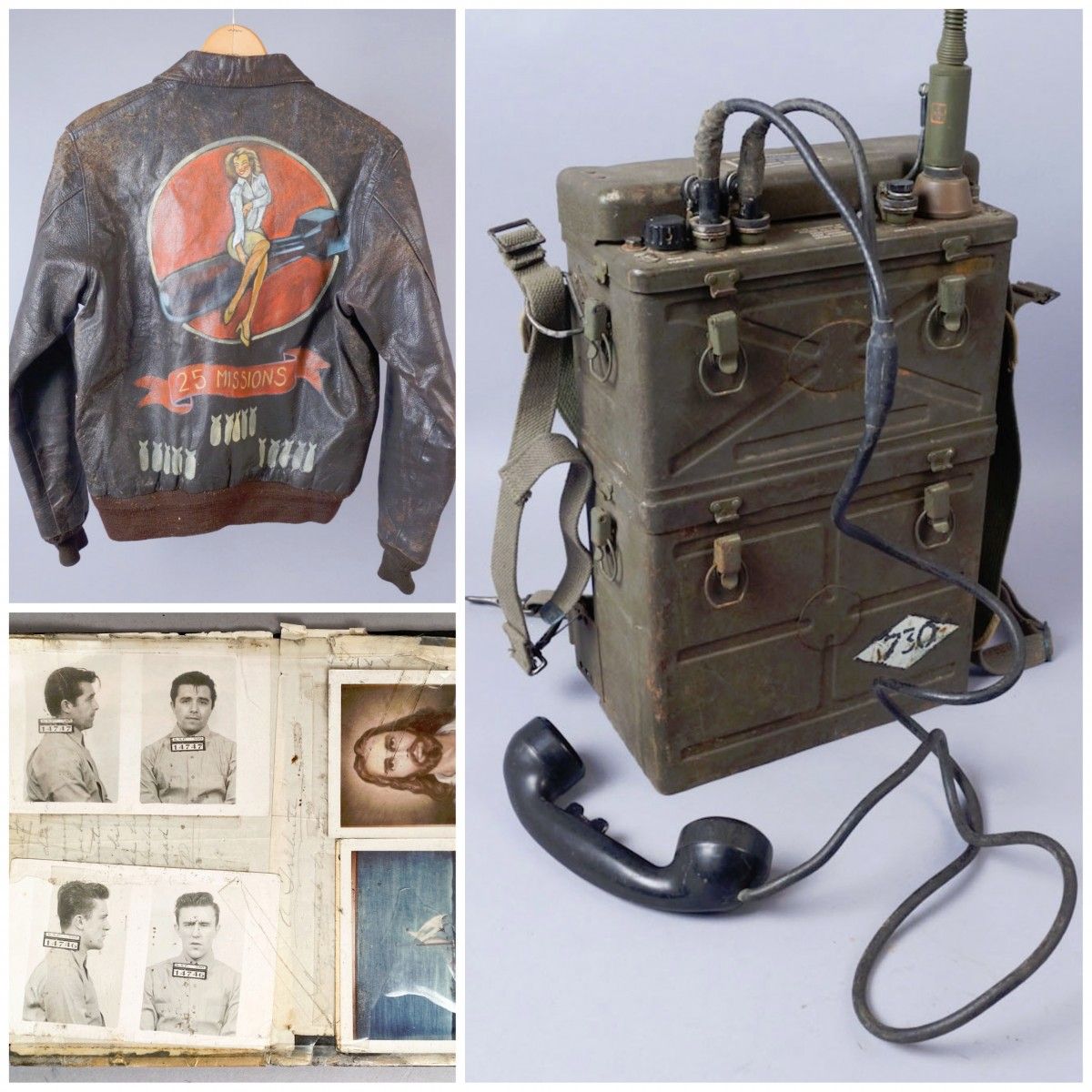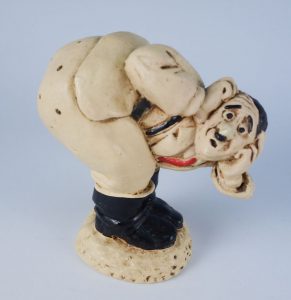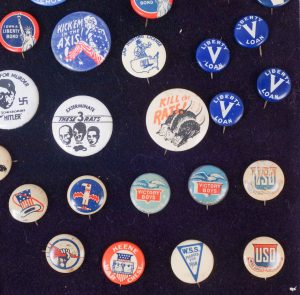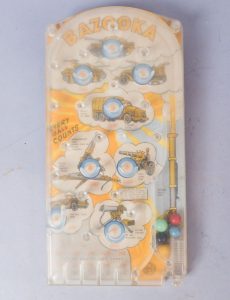
The Great American Propaganda Machine and the American Public + October 3rd Auction Event
By Alexandra Ponti
During World War II, supporting the troops was a part of your patriotic duty as an American. People all over the country planted victory gardens to grow their own fruits and vegetables, and everywhere you went, Uncle Sam told you to support the war effort by signing up to join the military or buy war bonds. Many of these recruiting posters still survive, and are the most familiar to people today. However, the war time culture pervaded even deeper into the everyday lives of all Americans, even children weren’t exempt from the propaganda of the American military machine. Any way the government thought it would be able to get the American public to support the war effort, they tried it.
Have you ever seen a caricature Hitler toothpick holder? No? How about a caricature Hitler piggy bank? No as well? Well, neither had I until a few months ago when I helped to catalog the expansive collection of an avid collector of anything and everything WWII. The collection contained the typical items that you would expect of a WWII collector: uniforms, scale models, and books. However, this collection went above and beyond the average collector; including items from the American home front.
Propaganda Item 1: Toothpick Hitler

In the 1940s, Americans loved nothing more than making fun of Hitler, and “putting him in his place” so to speak. The propaganda machine did this by satirizing Hitler and German people. The Popeye cartoon Seein’ Red, White, ‘N Blue, ends with Popeye punching Hitler in the face. The Three Stooges satirized the Nazis in many episodes with Moe portraying Hitler himself.
This toothpick holder may not be a child’s cartoon socking the Furher in the mouth, the holder depicts with a rather large derriere and a look of anguish on his face. At a 1944 party, this compromising depiction of the leader of the Third Reich would both amuse the guests and remind them why their brothers, fathers, and sons were risking their lives by fighting in this war. If not outright, this small figurine served a much larger purpose in the overall US propaganda machine.
Propaganda Item 2: Pins

Not everyone had caricature figurines of Hitler lying around their homes for parties. Since they were cheap and easy to make, many people wore pins to show their support for the war effort. Many of the pins people wore said “Victory Loan” “Welcome Home our Heroes”, or “Victory Loan”; some innocuous stuff. However, not all pins were so benign. A few, like the ones shown, display the wearer’s true feelings towards America’s enemies, mainly through violence. One depicts Uncle Sam with his leg raised and the slogan “kick ‘em in the Axis,” which gets the point across in more ways than one. The wearer expresses the belief for physical violence towards the U.S.A.’s foes that formed the Axis powers, and is a pun on the phrase “kick them in the a**”.
Another pin portrays Mousellini, Hitler, and Tojo, the leaders of Italy, Germany, and Japan respectively, as rats saying “Kill the Rats!”. This badge not only endorses violence against the country’s enemies, but debases the three leaders to something less than human, an animal that most people would rather see dead than alive.
The final pin, I will elucidate upon is the pin depicting Hitler’s face with the words, “Wanted for Murder, Adolf Schicklgruber, alias ‘Hitler’”. At first, meaning of the pin puzzled me. Where did the name Schicklgruber come from? After a quick search on Google, I learned Schicklgruber was Hitler’s father’s original last name. Hitler’s father, Alois, was born illegitimately, and no father was listed on the birth certificate, so he took his mother’s surname of Schicklgruber. Johann Georg Hiedler, or Hitler, married Alois’ mother, and Johann formally adopted Alois giving him the surname Hitler. By giving Hitler the surname Schicklgruber and not Hitler, shows that he had the inability to prove the identity of his legitimate grandfather, thus throwing his line of Aryan ancestry into doubt. If the leader of the proposed “perfect people” was not one himself, then how can he think he is fit to lead them if anyone who was an Aryan were considered “sub-human”? Also, if he is lying about his ancestry, then what else could he be lying about? This button delves much deeper than the buttons mentioned earlier, and is perhaps the most poignant and successful pin in terms of propaganda.
Propaganda Item 3: Children’s Games
Just because there was a war going on did not mean American children stopped playing with toys. The toys, at least those marketed toward boys, became almost entirely military oriented. Boys across the country were playing with toy howitzers and building B-17 Flying Fortress models out of balsa wood. These toys emulated their real counterparts currently used overseas against the Axis powers, depicting a clear correlation between boy and soldier. As a result, the nation’s propaganda machine did not spare America’s youth.

Of course not all toys were based on military vehicles, nor were they geared towards a single gender. Everyone has childhood memories of playing pinball, including children from the early 1940s. However, many of their games came military themed, like this child’s plastic “Bazooka” pinball game. The player had five chances to shoot rounds (plastic balls) out of their “bazooka” and hit various enemy targets whether it was an enemy tank, troop carrier, or gun placement. It has the slogan “every ball counts” so the player can emulate their soldier counterparts overseas using a real bazooka to fight America’s enemies. The various targets also describe the exact type of gun or vehicle at which the children were shooting, so they also learned about the types of enemy anti-aircraft guns and tanks. This form of propaganda is very efficient because the children did not even realize they were learning, they just thought they were playing a game and having fun.
American propaganda during WWII took many forms, of which I have only highlighted the more unusual types. Propaganda was a vital aspect of the American WWII military machine because if no one back home believed in what the soldiers were fighting for, then why should they?
Our Upcoming Auction
If you are interested in purchasing any of the items mentioned above, or are interested in any WWII memorabilia, we invite you to view the catalog for our upcoming “In Cold Blood” Memorabilia & Militaria Sale on October 3rd. For this sale, we have consigned a single owner collection of World War II era original United States armed forces equipment and memorabilia including Helmets, Uniforms, Field Equipment, Edged Weapons, Sweetheart Jewelry, etc., of an Upstate New York collector, as well as a nice group of 19th century American military percussion muskets and edged weapons.
We are offering a remarkable archive of artwork, photographs, poems and memorabilia of Perry Smith, one of the two notorious murderers of the Herbert Clutter family of Holcomb, Kansas. The story was told in the best selling 1966 book “In Cold Blood” by Truman Capote which was made into a blockbuster film of the same name. The items offered primarily comprise the personal scrapbook of Perry Smith which was gifted to prison Chaplain James Post immediately prior to Perry Smith’s execution by hanging on April 14, 1965. The group includes Smith’s personal copy of “On Man & Nature” by Henry David Thoreau, which is inscribed to Reverend Post and extensively annotated. There are also original mug shot photographs of Smith and Richard Holcomb from their arrest and incarceration at the Kansas State Penitentiary.
You can view the catalog and bid on items in the auction at:
LiveAuctioneers: https://www.liveauctioneers.com/catalog/179659_-in-cold-blood-memorabilia-and-militaria-sale/
Or
Invaluable: https://www.invaluable.com/catalog/g2exj258sj
If you have any militaria items please feel free to contact us. We would be happy to help. To schedule an appointment for a free purchase evaluation, call us today at (518) 587-8787 or contact us at marklawsonantiques@gmail.com. We have offices in Saratoga Springs and Colonie, conveniently located for our clients in the Albany, NY, and surrounding Capital Region.
